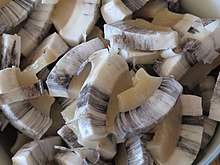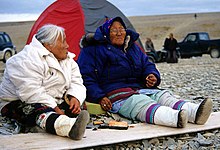マクタック
表示

マクタック(英語: muktuk)とは、クジラの皮を皮下脂肪をつけて切り取った、イヌイットとチュクチの伝統的な食事である[1]。

マクタックはホッキョククジラから作られることが最も多いが、 ベルーガやイッカクも使用される。通常はそのまま食べられるが、醬油をつけたり、最近ではさいの目に切ってパン粉をまぶして揚げ、醤油と一緒に出されることもある[2]。また、しばしばピクルスにされることもある[3]。生では非常に硬く、よほど慣れている人以外は鹿の子切りをしてから食べるが、茹でると柔らかくなる[4]。味はあっさりしており、臭いもほとんどない[4]。
マクタックは、グリーンランドでは工場に商業的に売られており[5]、カナダでは他のコミュニティに販売されている[6]。


マクタックはビタミンCの優れた供給源であることが判明しており、 皮には100gあたり最大38mgのビタミンCが含まれている[7][8]。そのため、イギリスの北極圏の探検家によって抗血栓剤として使用されたこともある[9]。また、脂身はビタミンDの供給源でもある[10]。
クジラが成長するにつれ、水銀は肝臓、腎臓、筋肉、脂肪に、カドミウムは脂肪に蓄積される[11]。PCB、人間の神経系、免疫系、生殖系に損傷を与える発がん性物質、海洋食物網[12] [13]やその他のさまざまな汚染物質から生物濃縮されたものも、マクタックには含まれている[14]。
イヌイナクトゥン語など一部の方言では、 マクタックという言葉はクジラの皮膚の部分のみを指し、 脂肪は指さない[15][16]。
関連項目
[編集]脚注
[編集]- ^ “muktuk”. Asuilaak Living Dictionary. 2020年4月閲覧。
- ^ Stern, Pamela (2009). The A to Z of the Inuit. Lanham: Scarecrow Press. pp. 101. ISBN 978-0-8108-6822-9
- ^ “10 Weirdest Foods in the World”. News.travel.aol.com (9 September 2010). 11 September 2013閲覧。[リンク切れ]
- ^ a b narwhal2. “イッカクのマクタックの味”. 生きもの写真家安田守の自然観察な日々(2005年1月-2007年9月). 2020年4月10日閲覧。
- ^ Heide-Jørgensen, Mads Peter (January 1994). “Distribution, exploitation and population status of white whales (Delphinapterus leucas) and narwhals (Monodon monoceros) in West Greenland” (英語). Meddelelser om Grønland, Bioscience 39: 135-149.
- ^ Hoover C, Bailey M, Higdon J, Ferguson SH, Sumalia R (March 2013). “Estimating the Economic Value of Narwhal and Beluga Hunts in Hudson Bay, Nunavut”. The Arctic Institute of North America 66: 1–16.
- ^ Geraci, Joseph R.; Smith, Thomas G. (1979). “Vitamin C in the Diet of Inuit Hunters From Holman, Northwest Territories”. Arctic 32 (2): 135–139. doi:10.14430/arctic2611. JSTOR 40508955.
- ^ Fediuk, K.; Hidiroglou, N.; Madère, R.; Kuhnlein, H. V. (2002). “Vitamin C in Inuit Traditional Food and Women's Diets”. Journal of Food Composition and Analysis 15 (3): 221. doi:10.1006/jfca.2002.1053.
- ^ McClintock, Francis Leopold, “CHAPTER XVI”, A Narrative of the Discovery of the Fate of Sir John Franklin and His Companions (Cambridge University Press): 301–322, ISBN 978-1-139-23652-2 2020年2月3日閲覧。
- ^ Kuhnlein, H. V.; Barthet, V.; Farren, A.; Falahi, E.; Leggee, D.; Receveur, O.; Berti, P. (2006). “Vitamins A, D, and E in Canadian Arctic traditional food and adult diets”. Journal of Food Composition and Analysis 19 (6–7): 495. doi:10.1016/j.jfca.2005.02.007.
- ^ Wagemann, R.; Snow, N.B.; Lutz, A.; Scott, D.P. (1983). “Heavy Metals in Tissues and Organs of the Narwhal (Monodon monoceras)”. Canadian Journal of Fisheries and Aquatic Sciences 40 (S2): s206–s214. doi:10.1139/f83-326.
- ^ “Chemical Compounds Found In Whale Blubber Are From Natural Sources, Not Industrial Contamination” (18 February 2005). 2020年4月閲覧。
- ^ “Japan warned on 'contaminated' blubber”. BBC News. (24 January 2001) 31 December 2009閲覧。
- ^ “Google Scholar”. scholar.google.com. 2018年11月18日閲覧。
- ^ Ohokak, G.; M. Kadlun; B. Harnum. Inuinnaqtun-English Dictionary. Kitikmeot Heritage Society 3 April 2016閲覧。
- ^ “edible whale skin”. Asuilaak Living Dictionary. 2020年4月閲覧。
